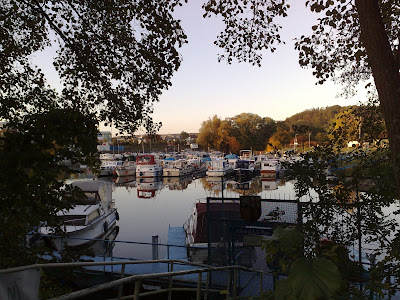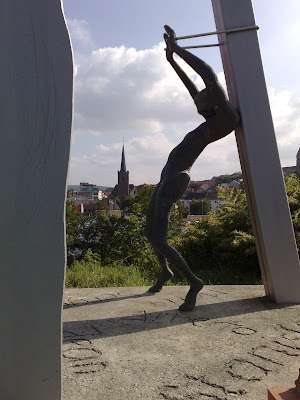2009-10-25
Octogonal Baroque
The Protestant Church (Evanglische Kirche), Bischmisheim, built in 1824 by Karl Friedrich Schinkel, radiating symmetrical eight-sidedness ever since.
2009-10-17
Korean totem pole
The pole must be a Jangseung, which according to Wikipedia, are traditionally placed at the edges of villages to mark for village boundaries and frighten away demons. They were also worshipped as village tutelary deities.
The photo was taken before the Korea Institute of Science and Technology Europe on the universtiy campus in Saarbrücken. The institute is currently expanding and constructing a second building next to this one. We have more than just closed pitheads and steelworks in Saarland.
2009-10-16
But wild ones live in sticks
Built as a home for wild bees, which gardeners and nature lovers are happy to have, as they pollinate their flowers even if they do not produce much honey.
2009-10-13
Tête-à-tête
Saarland may have an industrial past but it is certainly not a mass of sprawling, smoke-belching factories. What factories remain are clean and small scale, and scenes like this can be found a couple of kilometres from Saarbrücken.
2009-10-12
Beer in the woods
Follow the winding stairs from the ancient stones to the top of the hill, and there you may receive a magic potion.
2009-10-11
Der Stiefel - The Boot
This lies a few metres away from the Teufelstisch, but unlike its smaller companion it has been naturally formed from the coloured sandstone. Both stones are at the top of an imposing hill and remains of implements found nearby indicate that they have been the object of human attention for well over 6,000 years. The toe of the boot points to the Spellenstein. We can only guess what significance the three stones had in the lives of our stone age ancestors.
2009-10-10
Teufelstisch - Devil's Table
Another menhir. According to legend, this stone served as a table upon which a giant ate his human victims. The giant used the Spellenstein to sharpen the knife needed to chop up his victims. When a sortie of humans dared attack him in his mountain lair, he chased them away and threw the Spellenstein after them, which landed point downwards in the position we find it today.
2009-10-07
Spitzbunker - pointy bunker
This an example of a bunker built according to the design of Leo Winkel. Other names for such bunkers are Betonzigarre (concrete cigar) and Zuckerhut (sugar loaf) bunkers. About 200 were built. I have seen another one in Burbach in Saarbrücken. However, that one is on the grounds of the steelworks, and thus it it is hard to get close enough for a photo.
2009-10-05
Tag der Deutschen Einheit - Day of German Unity
October 3 is an annual national holiday, commemorating the reunification of Germany in 1990. Each year a different city hosts the main celebrations. This year it was Saarbrücken's turn. So, a town of 200,000 played host to a party with an estimated 500,000 participants. The 500-year old footbridge connecting events on both sides of the river was naturally rather packed.
2009-10-04
The wall - Day of German Unity 2009
This piece of the Berlin wall is always here in Saarbrücken. During the activities to commemorate the reunification of Germany it was of special interest.
2009-10-03
Statue before Neunkirchen
To be found on a promontory near the old steelworks. The statue is a work of Seiji Kimoto and is entitled Mahnmal für FremdarbeiterInnen (Memorial to Foreign Workers).
2009-10-02
Machinery as art
Near the old steelworks is a pleasant path through green fields dotted with old iron and steel products and works of art.
2009-10-01
Old Neunkirchen steelworks
This is what the water tower cooled. The last steel was produced in 1982. Since then the site has been redeveloped and these towers have been left standing as a reminder of the town's industrial heritage and to give photographers something to shoot.
Subscribe to:
Posts (Atom)






























